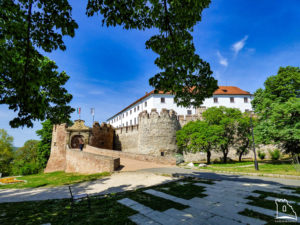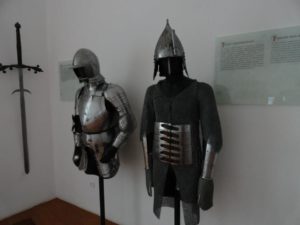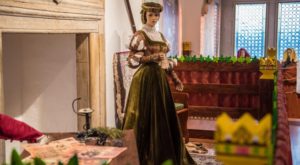Siklós

Siklós is located in the southern part of Hungary, the fort was first mentioned in 1294. The castle had a very active medieval history. Siklós castle has an inner tower with an irregular floor plan, consisting of an outer and an inner castle, it was built on a low hill. What makes it unique is that the castle has not undergone many changes in its medieval history.

During the Magyar tribes’ conquest of Hungary, this region became the home of the famous Khan family of the Botond tribe. The name of the settlement first appears in a charter of 1191 in the form of “villa Suklos”, when Buchk, the son of Siklósi Simon, and Jul (Gyula) were dividing the domains between each other. These estates were Siklós, Ostró, Kemes, and Szaporcza, and the business was done before the Chapter of Pécs. The foundations of the Siklós castle were laid by a member of this family after the Mongolian Tartar invasion of 1241-42.

The castle is first mentioned in the charter issued by the Chapter of Pécs in 1294 to the sons of Siklósi Miklós. (Note, I use the Eastern name order for Hungarians where family names come first.) The place was called “Castrum Soklos” when it belonged to Comes Siklósi Gyula, the lord of Baranya and Tolna counties, whose castellan was Comes András, son of Toppord Mihály in 1297.
The historical role of the castle began after the end of the Árpád House, at the time of the royal election. At that time the owner of the castle was Siklósi Péter, a follower of King Károly Róbert. However, Németújvári János, the son of Henrik of Héder rebelled against the king and wanted to occupy Siklós with a siege. Yet, his plan failed because Beremendi István from the Buchk branch of the Kán clan, related to the Siklós family, successfully defended it.

Unfortunately, after the siege, Beremendi could not account for the gold and silver objects entrusted to him, estimated at about 1,000 marks. In the lawsuit initiated for this purpose, in 1326, Sándor, the Judge of the Country, ordered the parties to a decisive duel. The parties were allowed to hire a duelist. Our diplomas do not mention who became the winner, but we know that the Beremendi family became impoverished, from which it can be concluded that Siklósi Péter won the lawsuit.

In the second half of the 14th century, after the death of King Louis the Great, some of the lords did not recognize the king’s daughter, Mary’s rule, and a rebellion broke out in the lands beyond the Dráva River. It was led by Bishop Pál of Zágráb and by Bán (Duke) Horváti János of Macsó. Simontornyai István was also among the leaders, they wanted to get the throne for Kis (Little) Károly of Durazzo. To prevent this, on behalf of Palatine Garai Miklós, with the consent of Queen Mary and Elizabeth, on February 7, 1386, Lord Forgách Balázs committed a murderous assassination attempt on Kis Károly in Buda Castle who died in his wounds not much later.
To put down the rebellion, Garai, Mary, and Elizabeth traveled to the South later this year but were captured at the village of Gara by Lord Horváti. Horváti had Garai beheaded, strangled Elizabeth, and locked Mary in her castle. Siklósi Miklós also joined the rebels, for which Sigismund, who had meanwhile been crowned king, took away the castle of Siklós and its accessories from the disloyal lord by a decree dated 13 April 1387 in Buda. Sigismund gave it to János and László, the sons of Pásztói Kakas but the sons of Pásztói Domokos and István (the kids were László and János) also received a part. They all belonged to the Rátót Clan.

After seven years, Siklós Castle and its accessories once again fell into the hands of the Garai family. They bought it back from the members of the Kakas family members. The rest of the domains were obtained by the Garai family through a barter they made with the last members of the Siklós family, namely with the Augustinian monk Miklós, the son of Pál. The good monk was appointed as the bishop of Osseró, in exchange for the business.

Then, the lords dissatisfied with Sigismund captured the king returning from Bohemia, on his way to Buda on April 28, 1401. They first locked him in the castle of Siklós for five months. From there, he was taken to the Castle of Pápa which also belonged to the Garai family. After the nobles could not agree on the identity of the new king, Garai Miklós, with the help of his followers, managed to reconcile the lords with Sigismund, who promised to return the castles in foreign hands to their owners, obey Hungarian laws and not punish those who rebelled against him. Sigismund, who was released from captivity, appointed Garai Miklós as a palatine, and from that time Siklós was also called “Civitas Palatinalis”, the city of the palatine, suggesting that his master was the palatine of the country.
The Garai family was discontinued, Garai Jób died in 1482, so together with the manor of the Siklós castle became the property of the crown, and as such, in April of this year, it was donated to King Matthias’ son, Corvin János. Corvin died in 1504 and his son Kristóf died in 1505, so Siklós fell into the hands of King Ulászló II, who donated it to Corvin’s widow, Beatrix Frangepán, and then to her second husband, George von Brandenburg, from whom Lord Újlaki Ferenc bought it.

According to Serbian sources, between 1508 and 1515, the landlord was Stefan Stilanovics. In 1515, King Ulászló donated the castle and his estate to Palatine Perényi Imre, who took great care to repair and expand it. He rebuilt the castle in the Renaissance style. He further enhanced the castle’s defensive capacity by filling in the wall gorges, building shield-shaped earth defenses, and erecting polygonal Italian-style bastions built in front of ramparts and castle walls. This is when the pentagonal bastion in front of the chapel and the Perényi-embossed bastion in front of the southern corner of the outer wall were completed.

The Palatine’s wife was Lady Kanizsai Dorottya who kept the fort after her husband’s death in 1519. This lady became renowned for bravely burying the dead of the Battle of Mohács in 1526. Perényi Ferenc also died in that battle. You can read about the Perényi Clan here:
https://www.hungarianottomanwars.com/essays/lord-perenyi-peter-1502-1548-part-one/
His brother, Péter was in charge of guarding the Hungarian Holy Crown. Péter later became Chief Comes of Temesvár (Timisoara), then Voivode of Transylvania. However, Péter decided to cede the crown to Szapolyai János who was crowned with it on 10 November 1526. Eventually, shortly after this Perényi Péter gave the crown to the Habsburg usurper, Ferdinand, who was also crowned with it in 1527.

After his coronation, Perényi had the Holy Crown brought to the castle of Siklós. After Szapolyai János had no choice but to side with the Turks in 1529, Perényi wanted to change sides and tried to take Ferdinand’s side. He wanted to go to Sárospatak Castle with the crown and badges. However, Bishop Szerecsen János, standing on the side of Szapolyai, learned of his betrayal and his plan. He captured Perényi along with his men at Kajdacs in Tolna County, locked him and his family in the castle of Pozsega, and transported the crown to the camp of the Turkish Sultan, who handed the crown over to Szapolyai.

Szapolyai was angry with Perényi but Suleiman ordered him to have mercy on Perényi. Thus, Perényi went over to King Szapolyai but after Szapolyai’s death in 1540, he began to support King Ferdinand. He was not lucky with him, King Ferdinand put him under arrest in 1542 for treason and kept him there for five years when he had to be released because of the Hungarian lords’ pressure. He died in 1548. In the absence of Perényi, Siklós Castle was entrusted to a castellan called Vas Mihály and his deputy, Nagy Zsigmond.

Here is a short video about the castle:
https://www.youtube.com/watch?v=k0EQJ3KfSPg
The fall of Siklós castle on 7 July 1543
Sultan Suleiman wanted to punish the attack of the Imperial troops who had besieged Pest. He led a huge army to Hungary in 1543. His first move was the taking of Valpó castle in the Szerémség (Sirmium) Region. When Székely Lukács, the captain of Valpó heard of his coming, he fled, along with the bishop. However, it took him a month to take it, it fell only on 22 June. Then, he sent Pasha Kara Achmed to Siklós castle who demanded the surrender of the fort. However, Vas Miklós, the commander of Siklós obeyed the instruction of his liege-lord, Perényi Péter, and refused to cede the castle.

Hearing so, Sultan Suleiman ordered the siege and sent 13 large cannons and 30 “zarbuzans” (wall breaches) to Achmed. Because of the heavy rains, it was not at all simple to transport the artillery to Siklós, the beys and the pashas had to offer money and gifts to their men to drag the cannons on the muddy roads. Finally, the enemy surrounded Siklós on 26 June. Pasha Achmed was the leader but the sultan also arrived there when the bridge of the Száva River was built.

While the Turks were completing the siege works around the castle, the defenders tried to start negotiations with the sultan. At this time, Perényi was in captivity and the guards were confused. After the futile talks, the cannons began to destroy the walls of the outer castle on 3 July. They could open huge gaps in them by the next day so the defenders had to withdraw into the inner castle. The enemy intruded into the outer castle at once and they deployed the cannons there during the night. The next day, the bombardment commenced from close range but they also dag mines.

During the night of 4 July, Malkocs Bey managed to capture a few defenders, a nobleman called János was among them. They were able to get information from him about the castle’s weak points. The next day, the troops of Mohamed Bey of Morea ran into a Hungarian cavalry unit near the castle. The Ottomans scattered them, 40 of the Hungarians were beheaded, and four captives were dragged before Pasha Rusztem. As it turned out, they were from Szigetvár castle, they were sent for fodder.

The bombardment of the castle went on, the cannons were destroying the walls of the inner castle from close range on 5-6 July. The defenders were utterly exhausted and wanted to start talks but the enemy did not listen to them at first. Finally, the sultan permitted them to leave the fort unharmed. Nobody hurt them, they just had to abandon their horses. When they left, the Agha of the Janissaries was the first to enter the castle. They found 50 captives in the dungeons, and they were released, and gifts were distributed among them. There were Hungarian peasants in the castle, they were ushered into the church of the outer castle. Then, Suleiman had an inventory of the castle’s weapons made. He entered the castle on 9 July. The next day, he summoned the spies and the Turk renegades who had sided with the Hungarians and executed them.

Suleiman’s army set out on 10 July and marched away toward Pécs castle. As for the defenders who yielded the unbalanced fight because they had run out of gunpowder, they were indeed offered safe conduct. All in all, the city fell after 8 days of siege and the castle after three days. When the defenders of Pécs castle received the news of the fall of Siklós, their captain fled and the burghers opened the gates before the Ottoman vanguard, led by Kászim Bey. Pécs was taken without a fight.

A fight at Siklós castle on 18 June 1566



Regarding Siklós, after the Ottoman occupation, the Christian burghers were slowly pushed out of the city. A mosque was built in the city and the Franciscan church was turned into a Muslim praying house, too. Evilja Chelebi, the famous Turkish traveler listed 7 mosques in the city in the 17th century. The Ottoman Turks used the castle and the city as a small regional and logistical center. They stored there a large amount of food and gunpowder. One of them can be seen today, nicely restored. The Ottomans built out the sewer system and they built a bath, too.

30 October 1686 The Imperial forces take Siklós back


Schärffenberg wrote the following about the defense works:
“…Siklós is a well-built fortress constructed by the Turks in recent times, consisting of two parts: the inner and the outer fortress. The strong wall that surrounds the inner castle is surrounded on all sides by an inner rampart. The main gate opens onto the wall of the large “cannon bastion” [Barbican] of the castle’s construction system. From there, a bridge connects the inner and outer castles. This is another place to avoid attacking, as the guns positioned here will fire flanking fire from both sides. The outer castle stands on an almost oval-shaped plateau, with a strong defensive wall with an outer tower and a three- or four-story cannon tower with circular defenses in the same place. The whole system of walls is surrounded by a well-maintained and very deep moat…”.

The contemporary newspapers of Munich and Vienna, discussing the events of the siege, also refer to the town and the castle: “…Siklós is a fortress in a very favorable position for the Turks. It is a very important place because it is one mile from the Drava River, the Turkish harbor was built there, and the palisade protecting it is supplied with guards and ammunition”. “It is built with bastion-like small forts, and some guns are placed in them…. “

About 200 soldiers and several officers were lost in the first attack. The next day, after setting fire to the palisade, they managed to enter and occupy the town. The Turks retreated to the citadel, which was immediately bombarded from the outside. Not only did they successfully destroy the walls, but they also silenced some of the castle’s cannons. Meanwhile, siege trenches were dug towards the walls.

By 29 October, three shafts had been dug and blown up, creating a large gap in the wall. The incendiary shells also caused a huge fire in the castle. Seeing the troops lined up for the attack, the commander raised the surrender flag. On 30 October, after 143 years of Turkish rule, Siklós Castle returned to Christian hands. After the unconditional surrender, the guards were taken prisoners, but their families were escorted to the border and sent home. Although the guards still had plenty of food, they had very little ammunition and could have defended themselves for barely two days.


The history of Siklós after the Ottoman rule
On December 1, 1698, Emperor Leopold I donated the castle and its lands to Imperial General Caprara Aeneas of Italian descent, who demolished the ruined parts and began to build the castle that can still be seen today. He also built a vault over the Barbican drawbridge into a permanent gate and bridge. After he died in 1701, the works were completed by the new owners, Count Batthyány Ádám and his son Prince Lajos. During the War of Independence of Prince Rákóczi Ferenc in 1705, General Bottyán occupied the castle and held it in his hands for a year.

A decade after the end of the War of Independence, the heirs of General Caprara sold the estate of Siklós in 1728 to Strattmann Eleonóra, the widow of Batthyány Ádám for 96,200 gold Forints.

Source: partly from Szibler Gábor
Dear Readers, I can only make this content available through small donations or by selling my books or T-shirts:
Please, feel free to support me with a coffee here:
You can check out my books on Amazon or Draft2Digital, they are available in hardcover, paperback, or ebook:
https://www.amazon.com/dp/198020490X or at https://books2read.com/b/boYd81


My work can also be followed and supported on Patreon: Become a Patron!http://Become a Patron!


Picture: Buda in 1490; the Gold Forint of King Matthias; the combined COA of King Matthias
Here are a few more pictures of Siklós castle:



































